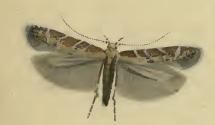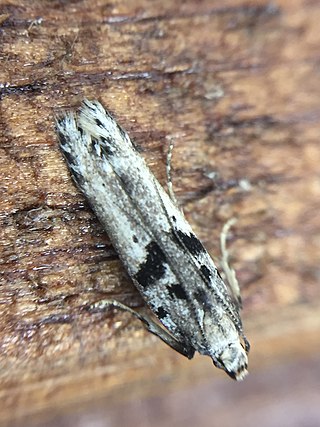
Aristotelia serrata, commonly known as wineberry or in the Māori language makomako or just mako, is a small tree in the family Elaeocarpaceae, in the genus Aristotelia, found in the North Island, South Island and Stewart Island of New Zealand. It is a small deciduous fast-growing tree or shrub. The tree can reach up to 10m tall, with a trunk diameter up to 30 cm. The bark is pale brown, smooth and patterned with flat lenticels. Branches are long, slender and spreading, branchlets have a reddish-brown colour when pubescent.

Aristotelia is a genus of moths in the family Gelechiidae. Well-known species are food plant specialists, and diverse hosts are used – Salicaceae, Solanaceae, Rosaceae, Fagaceae, Fabaceae, Asteraceae.

Aristotelia chilensis, known as maqui or Chilean wineberry, is a tree species in the Elaeocarpaceae family native to South America in the Valdivian temperate forests of Chile and adjacent regions of southern Argentina. Limited numbers of these trees are cultivated in gardens for their small edible fruits. Wild-harvested fruits are commercially marketed.
Agdistis frankeniae is a moth in the family Pterophoridae. It is found from Siberia through Central Asia, the northern parts of Asia and North Africa along the Mediterranean and in the west from the Canary Islands to southern France.

Aristotelia brizella is a moth of the family Gelechiidae. It is found in most of Europe, except Ireland, Switzerland and most of the Balkan Peninsula. Outside of Europe, it is found in North Africa and the Near East.

Aristotelia decurtella is a moth of the family Gelechiidae. It is found in large parts of Europe, except Ireland, Great Britain, the Netherlands, Portugal, Fennoscandia, the Baltic region, Poland, Ukraine and Romania.

Aristotelia heliacella is a moth of the family Gelechiidae. It is found in France, Switzerland, Austria, Germany, Italy, Finland, Norway and Sweden.
Aristotelia leonhardi is a moth of the family Gelechiidae. It is found in Austria.

Aristotelia subdecurtella, the brown fen neb, is a moth of the family Gelechiidae. It is found in most of Europe, except Norway, Belgium, Spain, Switzerland, the Czech Republic and most of the Balkan Peninsula. It is also found in the Russian Far East. The habitat consists of wetland areas.
Aristotelia ochroxysta is a moth of the family Gelechiidae. It was described by Edward Meyrick in 1929. It is found in North America, where it has been recorded from Texas.

Aristotelia paradesma is a moth of the family Gelechiidae. It was described by Edward Meyrick in 1885 and is endemic to New Zealand. This species has been observed on both the North and South Islands. The larvae feed on Coprosma species creating and living in stem galls. The adults are on the wing from November to March and are attracted to light.
Aristotelia adceanotha is a moth of the family Gelechiidae. It was described by Keifer in 1935. It is found in North America, where it has been recorded from California and Washington.
Aristotelia adenostomae is a moth of the family Gelechiidae. It was described by Keifer in 1933. It is found in North America, where it has been recorded from California.
Aristotelia amelanchierella is a moth of the family Gelechiidae. It was described by Annette Frances Braun in 1925. It is found in North America, where it has been recorded from Oklahoma, Utah, Washington and West Virginia.
Aristotelia argentifera is a moth of the family Gelechiidae. It was described by August Busck in 1903. It is found in North America, where it has been recorded from California and western Nevada.
Aristotelia corallina is a moth of the family Gelechiidae. It was described by Thomas de Grey, 6th Baron Walsingham, in 1909. It is found in Mexico (Guerrero) and the United States, where it has been recorded from Alabama, Arizona, Florida, Indiana, Louisiana, Mississippi, Oklahoma, Tennessee and Texas, as well as in Puerto Rico.
Aristotelia ivae is a moth of the family Gelechiidae. It was described by August Busck in 1900. It is found in North America, where it has been recorded from Florida and Georgia.

Aristotelia lespedezae is a moth of the family Gelechiidae. It was described by Annette Frances Braun in 1930. It is found in the United States, east of the Rocky Mountains.
Aristotelia planitia is a moth of the family Gelechiidae. It was described by Annette Frances Braun in 1925. It is found in North America, where it has been recorded from Utah.
Aristotelia pudibundella is a moth of the family Gelechiidae. It was described by Philipp Christoph Zeller in 1873. It is found on Haiti and St. Croix and in the United States, where it has been recorded from Alabama, Kansas, Louisiana, Maine, Mississippi, New Hampshire, Oklahoma, Quebec, Tennessee and Texas.







